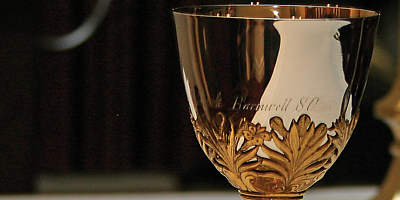CHARLESTON—When Father Gregory West came onboard as pastor of St. Mary of the Annunciation, he realized there was a grave problem that needed resolution.
It turns out the church’s graveyard, which dates back to the 1700s, had no official records of who was buried there. Father West said people would call the church looking for the burial spot of an ancestor and the church had no concrete way to help. The best they could do was walk among the monuments and look for names on the roughly 550 headstones.
So Father West tapped parishioner Mike Willson to lead a committee cataloging the old stones and to create a database of who is buried where.
Willson said he worked with other parishioners plus a team of graduate students in conservation from the College of Charleston, with the guidance of Professor Frances Ford. They helped research the history and map the plots.

“There are so many interesting people that are buried in here, and their stories are fascinating,” Willson said.
Several confederate soldiers are laid to rest at St. Mary, which suffered extensive damage to the church and graveyard during the bombardment of Charleston in the Civil War. In fact, a historical accounting of the church notes that many tombstones were broken beyond repair by falling shells and were gathered in a heap in a corner of the grounds.
Then, in 1896, “these broken memorials” were placed under the altar as the basis for its new foundation.
People who wander into the graveyard, tucked away from the noise and activity of King and Hassell Streets, feel as if they’ve stepped back in time. Surrounded by brick walls and ancient oaks, it is a quiet spot punctuated by the song of cicadas and birds.
Meandering, one sees many of the old inscriptions are written in French, and at least 12 countries are represented.
Bishop John England, the first bishop of Charleston, wrote about the graveyard, noting that regardless of country or culture they all “worshipped at the same altar” and “sleep in the hope of being resuscitated by the same trumpet.”
Willson said he is strongly impacted by the history of the graveyard and its symbolism regarding immigrants and how important they are to the Church.
He points to the resting spot of the first two priests of the diocese — Fathers Godfrey Sheehan and John Birmingham, both of Ireland — and Father Joseph Murphy, who was given special burial in 1998. Willson said the graveyard is officially inactive due to lack of space.
Cataloguing the dead and creating the online archive took about a year, Willson said, but now people can go to www.sma.church/graveyard.html, look up their ancestors and find their exact resting spot.
The next phase of the project is to lift the broken markers and repair them.
“As Catholics, we have a responsibility to take care of our dead,” Willson said.
Top photo, Miscellany: Mike Willson explains how they did rubbings of the old markers to help decipher the faded engravings.



